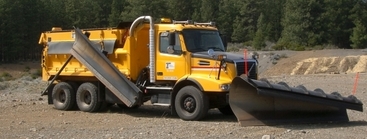
The ODOT Maintenance Academy is
a bi-annual, 12 day event held spring and the fall each year in Bend. It covers everything from workzone traffic
control, to winter operations, and heavy equipment operation. It has become in most part a
“boot camp” for new ODOT maintenance employees. The 12 day training event is split
between classroom, and hands on practical’s.
Over 50 instructors from across the state cycle through, and an
average of 40 students attend each Academy. Our
instructors are from the field, and are the best of the best in their topic of
instruction. The heavy equipment training portion
is held in a 35 acre pit on the way to Mt. Bachelor. 40 to 50 pieces of equipment
ranging from Bobcat skid steers with various attachments, to trackhoes, and
loaders are all part of the training.
This year, the Oregon T2 Center has partnered with ODOT Maintenance to provide two openings in the Spring Academy for T2 Customers. The academy will be held April 24-May 5, 2017 (including the weekend). The training is free of charge and all you need to send is your employee - travel and lodging is your responsibility. If you are interested in sending an employee to this training, email or call us!
|

Personnel Changes
Sue Raynor began March 1st as the new Circuit Rider/trainer for the T2 Center. She comes to us with a bachelor's degree in Occupational Safety and Health as well as a 25 year safety background. She joins our two other Circuit Riders in providing safety focused training and technical assistance to cities, counties, and tribal nations throughout Oregon.
Join us in welcoming Sue to her new role!
|
 Oregon T2 Center Director
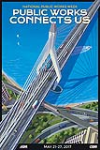
Public Works Connects Us
May 21-27, 2017
This year National Public Works Week celebrates the vital role public works plays in connecting us all together. As the cornerstone of civilization, public works provides, maintains, and improves the structures and services that assure a higher quality of life for our communities. Its streets, roads, bridges, and public transportation keep us linked together from coast to coast, and its clean water and sanitation services keep us healthy and allow our communities to grow and prosper. APWA proudly salutes and thanks the tens of thousands of public works professionals who work tirelessly throughout North America every day to strengthen the bond that keeps us all connected.
|
State Funded Local Projects (SFLP) is a new process for the
2015-18 STIP to provide state funds for federal projects selected under ODOT or
Transportation Management Area (TMA) funding programs. Local agency projects
are eligible for SFLP if they are selected through All Roads
Transportation Safety (ARTS), Enhance, Local Bridge, and Active Transportation
Discretionary selection processes. A portion of Surface Transportation Program
Urban (STP-U) and Transportation Alternatives Program (TAP) funds managed by
Transportation Management Areas (TMAs) are also eligible for state funding. All local agencies are eligible for state
funding through SFLP, subject to certain limitations. Agencies outside
of TMAs can state fund projects up to $5 million in total cost. Agencies inside
TMAs can state fund projects up to $1 million in total cost. Federal-aid projects not eligible for state
funding must be delivered as federal projects by either a certified
agency or by ODOT.
SFLP is similar to the current Surface Transportation Program (STP) Fund
Exchange process that many cities and counties utilize in that ODOT
provides 94 cents on the dollar up to the state share of project costs. SFLP is different in that
(1) state funding is provided to a specific project selected through ODOT
or TMA processes instead of a general allocation to agencies; (2) state
funds are spent first, followed by local agency funds if needed; and (3) local
agencies must complete a Final Inspection Form with their LAL at project
closeout. For ARTS projects, agencies must submit final cost and as-constructed
drawings. For bridge projects, agencies must submit the same materials as ARTS
projects, plus Structural Analysis Information, Foundation Reports, Hydraulic
Reports including Scour Analysis, Pile Records, and the Final Load Rating. SFLP does not change or replace the current STP
Fund Exchange process, but instead provides a new state funding option.
Projects currently approved for
SFLP are posted to ODOT’s
Project Funding webpage along with a printable overview handout. Local
agencies interested in state funding through the SFLP process should contact their
region Local Agency Liaison first to discuss options. For questions about the
contents of this article or State Funded Local Projects generally, contact the
following ODOT staff:
Scott Adams, PE
Local Agency Liaison, SW Area
541.957.3636 | scott.adams@odot.state.or.us
Cole Grisham, AICP
Local Public Agency Coordinator
503.986.3531 | nicholas.grisham@odot.state.or.us
 Free Road Safety Fundamentals Course
Join
transportation professionals from across the country for an in-depth study of
the fundamentals of road safety. Presented by the Road Safety Academy of the
UNC Highway Safety Research Center, Road Safety 101 is a free online course
designed for individuals new to transportation-related fields. It is based on
the NCHRP 17-40 Model Curriculum for Highway Safety Core Competencies. After
completing this course, students will understand the basics of developing and
implementing successful, collaborative road safety programs. Students will gain
a better understanding of road safety data collection, analysis, and
evaluation. Weekly sessions on Thursdays begin May 11 and go through June 29.
Session time is 10-12 weekly. Application deadline is March 30.
Click here to find out more and to complete an
application.
|

Free Courses
TC3 is offering both
Maintenance of Drainage Features for Safety and Earthworks
Series: Evacuation at no cost through the end of March 2017!
TC3 currently has 13 courses that are always free. Check them out at https://training.transportation.org/category_item.aspx?id=FC!
90% of TC3 Curriculum Now PDH-Eligible!
TC3 has always provided a robust online construction, maintenance, and
materials curriculum and is constantly looking for new ways to offer the best
possible training to the technical workforce. TC3 is excited to announce that
more than 90% of the 120+ courses are recommended for professional development
hours (PDHs)! When a trainee takes a PDH-eligible course, the training hours
can contribute toward continuing education for licensure renewal.
Additional Resources
TC3 not only provides technicians with excellent web-based courses that have been developed by TC3, but also provides access to other training resources that exist.
There are many good web-based classes and safety videos that have been developed by other organizations throughout the country. Most resources are free, but some may have a charge through the organization providing them. Please use this information to assist in providing educational information to your technicians.
https://tc3.transportation.org/training-resources/additional-training-resources/
When a crash happens on the road, we depend on traffic incident first responders to provide aid and clear the scene. But every year nationwide, we lose an average of 12 law enforcement officers, five fire and rescue personnel, and 60 tow and recovery professionals — all from secondary struck-by incidents while on a scene. Oregon’s first responders are on a mission to combat this fatal trend.
On Sept. 13, ODOT collaborated with Oregon State Police and the Federal Highway Administration to host Oregon’s 2016 Statewide Traffic Incident Management Conference. Dedicated to responder safety, this annual conference encourages cross-disciplinary communication and efficiency and safety training for first responders statewide.
ODOT’s Incident Management Coordinator Darin Weaver greeted about 70 representatives from law enforcement, transportation, towing, and fire and rescue as they gathered in Salem’s Hall of Heroes for the event.
Weaver shared that as of August, Oregon has trained 13.7 percent of its 26,350 first responders, gaining on the national average of 16.8 percent responders trained.
Momentum is critical for safety
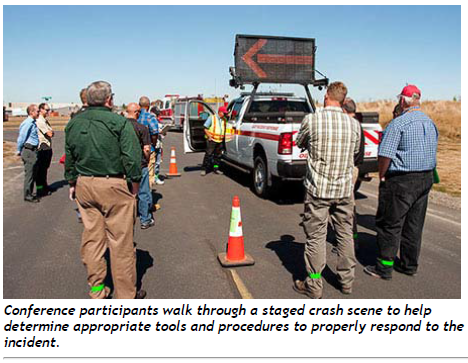 Changing the current culture is necessary to maintain the program’s momentum, Chief Deputy and Undersheriff Dan Kontos of the Portage County Sherriff’s Office in Wisconsin explained to the group. He discussed a dangerous and untrained incident scene that had resulted in a serious injury to a responder. That incident became the catalyst for change in Wisconsin’s own TIM program. Kontos shared his keys to changing culture and developing collaboration, facilitated with honesty and celebration of success.
Oregon celebrated its own successes at the conference. TIM trainers were recognized for their invested hours and commitment that helps keep first responders alive and safe. The winners attending the event were Sergio Mendoza from ODOT Region 3, Gary McClellan from Ray’s Towing in Eugene, Justin Guinan from Tangent Fire and Rescue, and David Moyer from ODOT Region 4. Darin Weaver was presented with the Diamond Recognition for the numerous hours he has dedicated to training.
Collaboration plays a huge role
Also celebrated was the inclusion of all first responder “voices” in the effort to collaborate among disciplines. To highlight the important integration of local agencies, ODOT Region 3 Public Information Officer Gary Leaming shared the success of Rogue Valley’s TIM team as they applied program principles to the OR 62 Expressway construction project. Board members from the Oregon Tow Truck Association showed their appreciation for the progressive involvement of their workers in first responder training and discussions, as tow professionals are often in the most danger when on a scene.
The conference armed responders with tangible tools they need for efficiency and safety. Groups walked through a static incident scene in the outside training village, illustrating the proper manuals and methods to approach a scene. Tools such as an incident database and a Robotic Total Measuring System showed attendees just how much technology can transform their work efficiency.
“I’d like to thank everyone who helped put this event together,” Weaver noted — another successful collaboration!
For more information, Oregon TIM responders invite you to like the Oregon TIM Responders Facebook page and join the community.
Reprinted with permission from InsideODOT
|
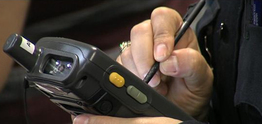
Through Every Day Counts (EDC) round
four, the Federal Highway Administration is promoting the use of low-cost,
off-the-shelf technologies to collect data to improve
traffic incident management (TIM).
TIM-related data can be collected with existing advanced
transportation management systems, computer-aided dispatch software, electronic
crash reporting systems, and smart devices. Some transportation agencies
already collect data with each of these systems.
The Arizona Department of Transportation, for example,
modified its Traffic and Criminal Software—or TraCS—system
at a low cost to collect data for three key TIM performance measures: roadway
clearance time, incident clearance time, and number of secondary crashes.
Tennessee uses a locally developed electronic crash reporting
system that collects data for two of the standard performance measures.
Visit FHWA’s TIM
Knowledge base for tools and resources on practices and performance
measurement.
|
Distracted Driving
by Tony Jobanek
In today’s driving environment with all of the risks we face on the road, distracted driving has become the top cause of crashes, deaths and injury on the American roadway. Distracted drivers have existed since the first automobile, but more recently driving risk has increased exponentially with the emergence of cell phone use while operating a motor vehicle.
Drivers have long had the allure of driving while distracted. You are driving distracted if you are eating, drinking, grooming, reading, using a navigation system, watching a video, adjusting a radio-CD player- MP3 player or just making eye contact with your passengers, Distracted drivers have put themselves and other road users at risk for a long time. Studies have shown distracted driving is equivalent in risk to drunk driving! With the advent of the cell phone, distracted driving has grown to new dangerous levels.
 The CDC (Center for Disease Control and prevention) has outlined the primary driving distractions into the following three categories:
Visual: taking your eyes off the road;
Manual: taking your hands off the wheel; and
Cognitive: taking your mind off of driving
In 2014 over 413,000
people were injured by distracted drivers.
The use of cell phones while driving is a heightened risk to
you and others on the road. Remember
driving is your primary focus while behind the wheel. In Oregon, drivers under 18 years of age are
not allowed to use a mobile communication device while operating a vehicle. Drivers 18 years of age and older are
required by Oregon law to use a hands free accessory while operating a motor
vehicle. Although studies have shown the
crash risk of a hands-free model is just as great as using a hand-held phone
due our conversations taking away attention from our driving responsibilities.
Texting is even more dangerous than talking on a cell
phone. A NHTSA (National Highway Traffic
Safety Administration) study showed drivers engaged in a phone call while
behind the wheel had a 2.3 times greater chance of being involved in a
crash. The same study indicated the
texting driver had a 23.2 times greater risk of being in a crash compared to
someone not distracted. Because text
messaging requires visual, manual, and cognitive attention from the driver, it
is by far the most alarming and dangerous distraction.
A Dartmouth study showed the use of cell phones as having
the same potential psychological effect as someone with a gambling addiction. The safest way to use cell phones is to pull
off the road before making your call.
Here is your homework
challenge, the next time you drive home from work shut off your phone, when you
pull into your driveway ask yourself an honest question, did it bother me or
give me anxiety to have the phone off? By shutting off your phone while you drive, you will not have the
temptation to look at it, make a call, text or look something up on the
internet. There are also numerous smart phone apps that can be used to curb the temptation to use your phone while driving.
Remember, by not driving while distracted, you will be doing yourself, your family, and other road users a huge favor not risking their lives by driving distracted.
|
 The Roads Scholar spring 2017 schedule is published! Classes are on a first-come, first-served basis and registration will close when the class is full.
Level 1 classes - Central and Eastern Oregon
RS-1 Basics of a Good Road, RS-2 Drainage: Key to Roads that Last, RS-9 Maintenance Math, and RS-10 Introduction to Survey will be offered the following dates and locations:
April 18-19 in Island City
April 25-26 in The Dalles
May 10-11 in Redmond
Level 2 classes
RS-11 Workplace Safety Training 1 will be offered in The Dalles on April 10.
RS-15 Roadway Safety Fundamentals 2 will be offered in the following dates and locations:
April 19 in Hillsboro
May 19 in Eugene
May 17 in Bend
Click here for class schedule, information, and registration.
|

Safety Analyst is a set of software tools used by agencies for highway safety management. Safety Analyst implements state-of-the-art analytical procedures for use in the decision-making process to identify and manage a systemwide program of site-specific improvements to enhance highway safety by cost-effective means. The software automates procedures to assist highway agencies in implementing the six main steps of the highway safety management process, including: network screening, diagnosis, countermeasure selection, economic appraisal, priority ranking, and countermeasure evaluation. Safety Analyst was developed as a cooperative effort by FHWA and participating state and local agencies.
The Network Screening identifies sites with potential for safety improvements.
The Diagnosis Tool diagnoses the nature of safety problems at specific sites.
The Countermeasure Selection Tool assists users in the selection of countermeasures to reduce crash frequency and severity at specific sites.
The Economic Appraisal Tool performs an economic appraisal of a specific countermeasure or of several alternative countermeasures for a specific site.
The Priority Ranking Tool provides a priority ranking of sites and proposed improvement projects based on the benefit and cost estimates determined by the economic appraisal tool.
The Countermeasure Evaluation Tool provides the capability to conduct before-and-after evaluations of implemented safety improvements.
More information about Safety Analyst is available at http://www.safetyanalyst.org/.
|
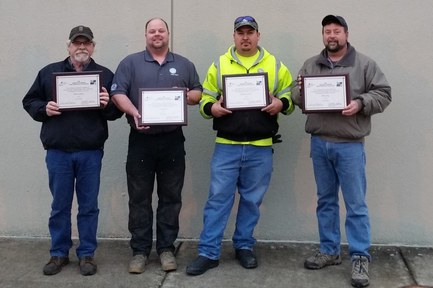 |
|
City of Eugene Roads Scholars
[left to right]
Kevin Leidall, Cory Jensen, Leobardo Corrales, and Brian Siria.
|
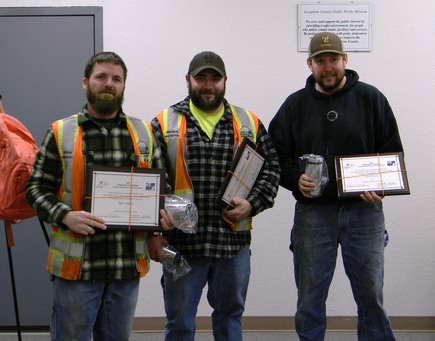 |
|
Josephine County Roads Scholars
[left to right] Ryan Gregory, Reuben Hayden, and Jerrod Bruner.
|
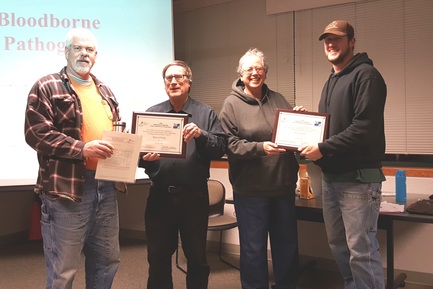 |
|
Marion County Roads Scholars
[center] Don Newell and Evelyn Pech present [left] Ray Boring and [right] Brent Garrison their Roads Scholar certificates.
|
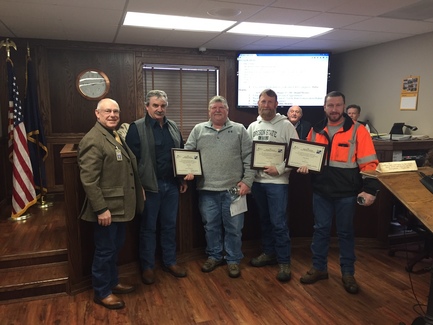 |
|
Umatilla County Roads Scholars
[left to right] Umatilla County Board
of Commissioners chairman Larry Givens and Public Works Director Tom
Fellows present Doug Hall, Loren Bullock, and Cory Hardy their Roads Scholar certificates.
|
 Tribal Transportation Safety
http://www.tribalsafety.org/
An online community for practitioners that have a role in reducing injuries and fatalities from transportation incidents. Contents of this site are provided by participating Tribes, Federal and State partners and TTAP Centers.
|
 Analysis of Construction Quality Assurance Procedures on Federally Funded Local Public Agency Projects
https://www.fhwa.dot.gov/publications/research/infrastructure/pavements/15008/15008.pdf
Approximately 20 percent of the Federal-aid highway program is invested in local public agency (LPA) infrastructure projects. This report documents current construction QA practices from both State transportation department and LPA perspectives, identifies specific issues or areas of weakness in QA practices, identifies existing successful QA practices, and makes recommendations that can be implemented to generally improve construction QA across the full spectrum of LPA projects and State transportation department programs. Recognizing that there are significant differences in LPA capabilities and project types, the recommendations consider both large and small LPAs, and differences among State transportation department programs.
|

The next webinar will be conducted on April 20, 2017 from 2:00-3:30 pm Eastern
Time and cover Chapter 4 – Pavement Condition Assessment. In addition, a state
and local representative will give their perspective on how they are
implementing Sections 4.1 to 4.5. The remainder of the chapter will be covered
in the July webinar. Additional information on the webinars and recordings may
be found at FHWA’s Pavement Management and Performance website (http://www.fhwa.dot.gov/pavement/mana.cfm).
There is no cost for this Webinar but registration is required. To register for
the webinar, go to:
https://collaboration.fhwa.dot.gov/dot/fhwa/WC/Lists/Seminars/DispForm.aspx?ID=1037
Background
FHWA, AASHTO Joint Technical Committee on Pavements, TRB Committee AFD10, Pavement Management Systems, and AFD20, Pavement Condition Evaluation, are hosting a series of quarterly webinars. The purpose of the webinars is to provide a forum for education and communication for pavement management practitioners. The initial focus of the webinars will be a “book club” format of the Pavement Management Guide, Second Edition 2012 published by AASHTO.
|
Uniform Traffic Control Devices Workshop
April 25-27
This course is designed for persons responsible for signing, signalization, and road marking. The class provides instruction and practice in the use of the Manual on Uniform Traffic Control Devices and the Oregon supplements to the Manual. Changes in the 2010 Manual will be addressed.
This workshop will provide an in-depth understanding of the warrants, applications and use of traffic control devices as required by the 2010 MUTCD and Oregon Supplements.
Click the following link for a more detailed description of the class and information on how to register: http://cce.oregonstate.edu/traffic-safety-workshops.
This flagger has put themselves at risk in a couple of ways.
When possible, always try to stand on the shoulder of the lane
you are controlling. If
you must move to the center lane, never turn you back on traffic. While it is acceptable for a flagger to move
near to the center line once several vehicles have stopped, only do so if the flagger's visibility is
better due to curves or large vehicles blocking oncoming driver’s sight of the
flagger.
When flagging, it is advisable to use a support pole for
your stop/slow sign to ensure fatigue does not force you to do what this
flagger is doing. Also, to permit unobstructed vision of all traffic flow from the flagging station, the bottom of the
stop/slow sign should be above the eye level of the flagger.
|